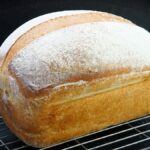
Simple White Bread (Split Tin Loaf)
An easy classic that's perfect for sandwiches and toast, here the dough is enriched with a little butter for extra flavour and aroma.
Ingredients
- 675 g strong white bread flour (plus extra for dusting)
- 2 level tsp salt
- 1.5 tsp instant dried yeast (i.e. the type that does not need activating before adding to the rest of the ingredients
- 1.5 level tsp sugar
- 25 g butter (plus extra for greasing the tin)
- 400 - 425 ml warm water (see Recipe Notes)
- 1 tsp bland oil (e.g. sunflower) for greasing the bowl
Instructions
-
In a large bowl, stir together the flour, yeast, salt, and sugar.
Melt the butter then make a well in the centre of the flour and pour in the butter.
Add 350 ml of the warm water, stirring as you do so, to start bringing the mixture together. Gradually add more water until the dough is almost formed - it doesn't matter if there are a few bits of loose flour at this stage.
Note: different flours absorb different amounts of liquid, so you may not need all the water or you may need a splash more but the dough should be neither wet nor dry.
-
Tip the dough and any remaining flour from the bowl onto a clean work surface or silicone mat. Fold and knead to form a dough, only adding a little extra flour if needed to prevent sticking or a splash of water if it seems dry.
Keep kneading for 10 minutes or until you have a soft, smooth ball of dough that immediately springs back when you poke a finger into it.
-
Wipe out the bowl and put 1 tsp of oil in the bottom.
Turn the dough in the oil to coat it, then cover the bowl and put in a warm place (e.g. an oven heated to very low then turned off) or until doubled in size (approx. 60 minutes, or longer in a cooler place).
-
Grease a 950 ml / 2 lb capacity loaf tin with butter then dust it with flour.
When the dough is risen, transfer it to your work surface.
Fold the dough over itself several times until it's smooth, at the same time shaping it to fit the length of the loaf tin: try not to add more flour, only if necessary to prevent the dough sticking to the work surface.
Put the dough in the prepared tin and place in a large polythene bag or cover with a wet tea towel. Set aside in a warm place until almost doubled in size (30 - 45 minutes).
-
While the dough is proving:
Preheat your oven to 220°C / 200°Fan /Gas 7 / 425°F with a shelf in the middle. Place another shelf in the lowest position and put a deep roasting tray on it to preheat (later, you will pour in cold water to create steam and help the bread rise).
-
Check that the dough is proofed:
If, when a finger is gently poked into the dough, the dough slowly springs back but leaves a slight indentation then it is ready to bake.
If the dough springs back quickly then it's not yet fully proofed: leave another 5 -10 minutes and check again.
-
Optional: Using a small sieve, sift flour over the surface of the dough.
-
Take a sharp knife or bakers lame and make a deep cut all along the length of the dough. Tip: brushing a little cold water along the cut encourages it to open up.
Place the tin in the oven then pour cold water from a jug into the hot roasting tray below. Immediately close the door.
Bake for 20 minutes.
-
After 20 minutes reduce the oven temperature to 200°C / 180°Fan /Gas 6 / 400°F.
Cook for a further 20 - 25 minutes or until the bottom of the loaf sounds hollow if you take it out of the tin and tap it. If the loaf is browning too quickly, turn the heat down a little.
Caution keep your face, hands etc. out of the way when you open the oven door in case any hot steam billows out.
-
Remove from the tin and place on a wire rack until completely cold before slicing.
Best eaten within 2-3 days or can be frozen.
Tip: slice before freezing so you can take out just as much as you need without wastage.
Recipe Notes
Water temperature
Ideally, the temperature of the water should be 38 degrees Centigrade. If you don't have a food thermometer then the water should be pleasantly warm if you put a finger in it, not hot. If in doubt, err on the side of cooler: the dough will take longer to rise, but this is better than hot water killing the yeast.
Amount of water
Different flours absorb varying amounts of liquid, so it isn't possible to be exact about how much water you will need, but it's likely to be around 400 ml. I recommend making up a 450 ml jug of warm water and just use as much as you need.